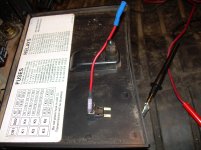SPYDERLK
Super Star Member
- Joined
- Feb 28, 2006
- Messages
- 10,331
- Location
- VA
- Tractor
- JD2010, Kubota3450,2550, Mahindra 7520 w FEL w Skid Steer QC w/Tilt Tatch, & BH, BX1500
It actually is confusing and hard to give a definitive answer, but here are the issues:I know the lights get brighter but what about the Ohm's law?
110 watts divided by 12 volts = 9.16 amps
110 watts divided by 13.5 volts = 8.14 amps
If this is what Rus Geek is getting at, makes sense.
But your point makes sense to me to, seems brighter light would mean more amps???
now I'm confused
JB.
1] As a conductor gets hotter its Resistance goes up.
2] When it gets very hot it reaches a point where thermal runaway occurs - the resistance goes up faster and faster as T continues to rise.
3] Incandescent light bulb filaments operate in this region of thermal runaway.
4] So... what happens when you turn on a bulb is that the current is way high and then plummets [too quickly to blo the fuse] as the filament heats.
5] Now you have the bulb running at its 12V brilliance and outputting P=IE Watts. When you suddenly increase E to 13.5V there is an initial corresponding increase in I. This causes a spike in P because both I&E are up. The spike in P lasts for a couple milliSeconds while the filament heats. The energy in this spike region goes into heating the filament.
6] ... but while the filament is gaining T its Resistance is avalanching upward
and making I drop back to essentially the same value that it was at 12V.
7] The P spike subsides to a steady higher plateau than was there at 12V. Even tho the current is almost identical to original the light burns brighter because the E value is 13.5 instead of 12.
larry

